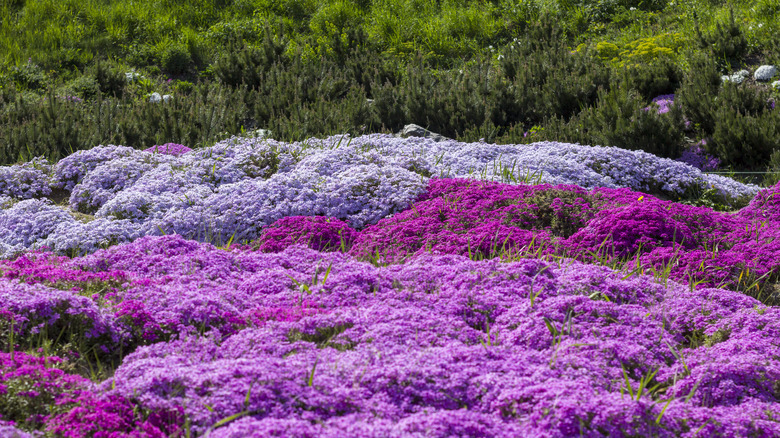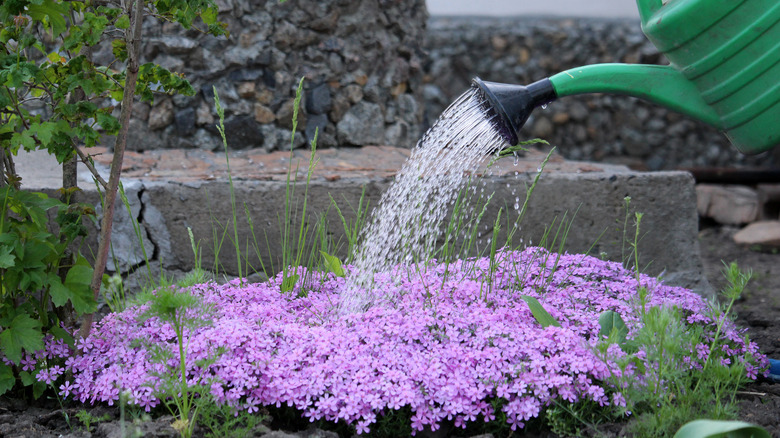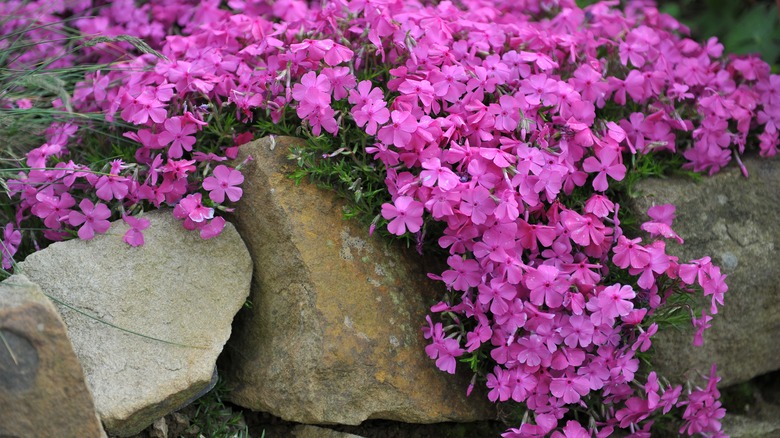Here's When You Should Be Planting Creeping Phlox For A Garden Full Of Color
Creeping phlox is the perfect low-growing groundcovers for sunny spots. Creeping phlox's beautiful flowers come in shades of pink and purple and can completely cover the plant. While creeping phlox is a perennial in zones 3 through 9, planting bare roots as soon as you can work the soil and planting young starts in the spring after your last frost will give your phlox the best chance of getting established and thriving in your garden for years to come.
Creeping phlox plants can refer to either Phlox subulata and Phlox stolonifera. Both are native to North America and unlike many other kinds of phlox, rarely grow over a foot tall. Phlox subulata can spread up to 3 feet wide, making for a stunning low-growing ground cover plant. It can even be used as a lawn alternative, as it can handle light foot traffic. Be sure to plant your creeping phlox in soil with good drainage and plenty of organic matter. While Phlox stolonifera can handle either neutral or acidic soil, Phlox subulata grows best in soil with a pH less than 6.
Planting your creeping phlox
While many other species of phlox are readily available from seed, Phlox subulata and Phlox stolonifera are generally purchased as small starts or as bare roots. Bare roots are dormant so they can be planted as soon as you can work the ground, but young plants in plug trays are more vulnerable to the cold. Ideally, you will buy your phlox at the perfect time for planting it, but if there is still frost or snow in the forecast then you may need to hold off on planting.
Even though creeping phlox is a perennial, young plants, especially those that have been grown in greenhouses or other protected locations, are vulnerable to frost damage. Therefore it's best to wait until any danger of frost has passed to plant them in the ground. As important as it is to not subject your phlox to frost before it has time to get established, it's also essential to avoid transplanting in the sweltering summer heat to avoid stressing your plant. You can keep your plant indoors or in a protected location outside until temperatures are appropriate for planting. If you aren't able to plant your creeping phlox in late spring, then early fall is also a good option as long as it's at least a month before your first frost date. This should give your plant time to get established before the frost.
Caring for your creeping phlox
Creeping phlox can be a perfect option in landscapes near the front of a garden border or spilling over the side of a container. If you opt to keep your creeping phlox in a container garden year-round, remember that during the winter the roots of plants in above-ground containers can get far colder than those of plants in the landscape. This can equate to a difference of up to two USDA zones according to Penn State Extension. Additionally, container plants usually need more regular watering during the summer to prevent them from drying out.
Regardless of whether you choose to grow your creeping phlox in a container or the landscape, be sure to mulch it well to protect the roots from sudden temperature fluctuations. Many perennials take a few years to get fully established, so don't panic if your phlox doesn't immediately take off. You can also plant a low-growing annual phlox like shorter varieties of Phlox drummondii to provide color and groundcover while you wait for your perennial creeping phlox to fill in.


